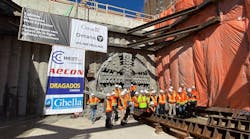Following a dip in rail openings due to various factors associated with the COVID-19 pandemic, supply chain challenges and construction quality issues, new rail transit and passenger rail projects in North America are being celebrated with ribbon cuttings from Honolulu, Hawaii, to Montreal, Quebec, Canada.
Since the 2023 Rail Special Report was published, several rail projects have entered revenue service, including the Los Angeles County Metropolitan Transportation Authority’s Regional Connector, Honolulu’s elevated autonomous rail system, Skyline, Réseau express métropolitain South Shore Branch in Montréal, Quebec, Brightline’s extension to Orlando, Fla., the Valley Line Southeast light-rail in Edmonton, Alberta, TriRail’s extension to MiamiCentral Station, Valley Metro’s Northwest Phase II extension in Phoenix, Ariz., the first segment of South Transit’s Link 2 Line and the Northern Indiana Commuter Transportation District’s Double Track Northwest Indiana project.
Additional projects are expected to enter service later in 2024, including Massachusetts Department of Transportation’s South Coast Rail project, Metrolinx’s Finch West Light Rail Transit and, possibly, its Eglinton Crosstown project.
Major maintenance projects are also producing operational gains for rail operators. In April 2024, Metropolitan Transportation Authority (MTA) returned regular service to F and M trains following completion of an eight-month track replacement project. In November 2023, the Massachusetts Bay Transportation Authority (MBTA) launched its Track Improvement Program, which aims to eliminate all speed restrictions in place and bring tracks closer to a state of good repair by the end of 2024. Between November 2023 and May 1, 2024, MBTA has removed a total of 104 speed restrictions following maintenance work on its Red, Orange, Blue and Green lines.
New and improved services have helped propel ridership gains on rail modes. The American Public Transportation Association Quarterly and Annual Totals by Mode ridership report shows heavy rail, light rail and commuter rail account for 46 percent of all transit trips taken in 2023. All rail modes saw an increase in ridership in 2023 compared to 2022, with heavy rail increasing 14.3 percent, light rail increasing 15.3 percent and commuter rail increasing 18.7 percent. While year over year ridership increases have slowed slightly, ridership as compared to year end 2020 numbers show a robust recovery. Light-rail ridership in 2023 increased 51.3 percent versus 2020, heavy rail increased 75.5 percent and commuter rail increased 80 percent. Regarding intercity passenger rail, Amtrak reports its ridership in Fiscal Year 2023 exceeded 28 million nationwide. The railroad credits this bump to significant growth on the Northeast Corridor, where ridership surpassed pre-pandemic levels since early summer 2023.
An April 17 hearing of the U.S. House Committee on Transportation & Infrastructure Railroads, Pipelines, and Hazardous Materials Subcommittee examined the state of the commuter rail industry and the challenges and solutions found within it. Among the topics highlighted at the hearing was the challenge commuter railroads face in a hardened insurance market. Mike Noland, president, Northern Indiana Commuter Transportation District and chairman of the Commuter Rail Coalition (CRC), summarized the issue by explaining commuter railroads carry $323 million in excess liability coverage, which is the federal cap. This cap will be changed in early 2026 in line with the consumer price index and a notice will be published by the U.S. Department of Transportation (USDOT), which will give commuter railroads 30 days to secure the additional coverage.
A maximum of $32.5 million per railroad can be purchased from domestic insurance carriers, forcing commuter railroads to use overseas insurance markets to secure the balance. The potential outcome for not securing the additional coverage could be suspension of operations.
In a column for Mass Transit, CRC CEO KellyAnne Gallagher called the state of the excess liability insurance market “illogical.” CRC is suggesting a multi-state agreement to share liability, the federal government offering a backstop should the excess liability insurance market fail and extending the 30-day implementation window to 365 days as potential solutions to aid commuter railroads.
“Extending the 30-day implementation window to 365 days will ensure commuter railroads in the U.S. can have the time necessary to secure the additional coverage and allow them to operate with confidence. Stabilizing the U.S. insurance market will allow taxpayer money to stay within the borders of the United States. We need both solutions for a prosperous future for commuter rail,” wrote Gallagher.
Further Safety Enhancements
Rail has statistically been a safe travel mode. The Bureau of Transportation Statistics shows injuries per 100 million passenger train-miles fell from 1,639.6 – the highest level during the past 10 years – to 547.7 in 2023. Fatalities per 100 million passenger train-miles fell from 6.7 in 2022 to 0.9 in 2023.
While ambassador programs and increased levels of security personnel have enhanced safety, rail transit and passenger railroads have also been embracing technology to support their commitment to operating safely and providing a safe environment in which to travel and work.
At the end of June, at the conclusion of a mandatory 90-day advance notice, New York City (NYC) will be piloting electromagnetic weapons detection technology to spot weapons carried by travelers onto the MTA system. NYC Mayor Eric Adams says the New York Police Department seized 1,515 weapons in the subway system in 2023, which is an increase from the 947 weapons seized in the previous year. The pilot program will be rolled out to designated subway stations where it will be evaluated.
Across the Hudson River, New Jersey Transit will be using a Strengthening Mobility and Revolutionizing Transportation Grant (SMART) from USDOT to work with Rutgers University Center for Advanced Infrastructure and Transportation to develop artificial intelligence-based systems to improve safety at light-rail grade crossings by reducing accidents at crossings and rights of way. Stage 1 of the project will prototype a tailored artificial intelligence-powered technology solution consisting of stationary cameras at five light-rail grade crossings and forward-facing cameras in one Hudson-Bergen Light Rail vehicle. Stage 2 of the project will see the technology installed at 50 crossings and five light-rail vehicles.
On the West Coast, Metrolink will use its SMART grant to develop and demonstrate a track intrusion detection system. The prototype will explore the use of artificial intelligence-equipped cameras and radar or light detection and ranging sensors in connection with Metrolink’s existing Positive Train Control system to identify and validate track intrusions.
One of the more impactful changes coming to rail transit safety concerns a rule change by the Federal Transit Administration (FTA). On March 22, FTA published a Notice of Proposed Rulemaking (NPRM) proposing mandatory minimum standards for trackworkers who work for rail transit agencies. While FTA provides guidance through the National Public Transportation Safety Plan to ensure safety on transit systems, it contains voluntary minimum safety standards. The proposed rule would mandate minimum safety standards for the first time. FTA explained in the NPRM its safety program has matured and it is now appropriate for FTA to propose required minimum standards for Roadway Worker Protection (RWP).
The proposed rule would require rail transit agencies to adopt and implement an RWP Program, establish minimum RWP elements, document RWP programs and implement RWP training.
"This rule will ultimately save lives," said FTA Acting Administrator Veronica Vanterpool. "Once this rule is finalized, it will support safer conditions for workers who perform critical tasks that keep transit operating efficiently and safely."

Mischa Wanek-Libman | Group Editorial Director
Mischa Wanek-Libman is director of communications with Transdev North America. She has more than 20 years of experience working in the transportation industry covering construction projects, engineering challenges, transit and rail operations and best practices.
Wanek-Libman has held top editorial positions at freight rail and public transportation business-to-business publications including as editor-in-chief and editorial director of Mass Transit from 2018-2024. She has been recognized for editorial excellence through her individual work, as well as for collaborative content.
She is an active member of the American Public Transportation Association's Marketing and Communications Committee and served 14 years as a Board Observer on the National Railroad Construction and Maintenance Association (NRC) Board of Directors.
She is a graduate of Drake University in Des Moines, Iowa, where she earned a Bachelor of Arts degree in Journalism and Mass Communication.






